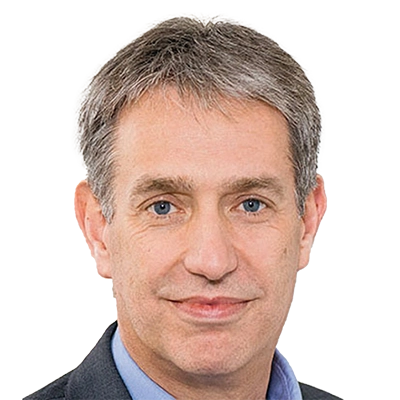Research Group Georgios Kaissis
Artificial Intelligence in Healthcare and Medicine
Georgios Kaissis
is a senior research scientist at the Institute of Artificial Intelligence and Informatics in Medicine and specialist diagnostic radiologist at the Institute for Radiology at TU Munich.
His research concentrates on biomedical image analysis with a focus on next-generation privacy-preserving machine learning methods as well as probabilistic methods for the design and deployment of robust, secure, fair and transparent machine learning algorithms to medical imaging workflows.
Publications @MCML
2025
Cross-domain and Cross-dimension Learning for Image-to-Graph Transformers.
WACV 2025 - IEEE/CVF Winter Conference on Applications of Computer Vision. Tucson, AZ, USA, Feb 28-Mar 04, 2025. To be published. Preprint available. arXiv
Abstract
Direct image-to-graph transformation is a challenging task that involves solving object detection and relationship prediction in a single model. Due to this task’s complexity, large training datasets are rare in many domains, making the training of deep-learning methods challenging. This data sparsity necessitates transfer learning strategies akin to the state-of-the-art in general computer vision. In this work, we introduce a set of methods enabling cross-domain and cross-dimension learning for image-to-graph transformers. We propose (1) a regularized edge sampling loss to effectively learn object relations in multiple domains with different numbers of edges, (2) a domain adaptation framework for image-to-graph transformers aligning image- and graph-level features from different domains, and (3) a projection function that allows using 2D data for training 3D transformers. We demonstrate our method’s utility in cross-domain and cross-dimension experiments, where we utilize labeled data from 2D road networks for simultaneous learning in vastly different target domains. Our method consistently outperforms standard transfer learning and self-supervised pretraining on challenging benchmarks, such as retinal or whole-brain vessel graph extraction.
MCML Authors
Artificial Intelligence in Healthcare and Medicine
2024
Attack-Aware Noise Calibration for Differential Privacy.
Preprint (Nov. 2024). arXiv URL
Abstract
Differential privacy (DP) is a widely used approach for mitigating privacy risks when training machine learning models on sensitive data. DP mechanisms add noise during training to limit the risk of information leakage. The scale of the added noise is critical, as it determines the trade-off between privacy and utility. The standard practice is to select the noise scale to satisfy a given privacy budget ε. This privacy budget is in turn interpreted in terms of operational attack risks, such as accuracy, sensitivity, and specificity of inference attacks aimed to recover information about the training data records. We show that first calibrating the noise scale to a privacy budget ε, and then translating {epsilon} to attack risk leads to overly conservative risk assessments and unnecessarily low utility. Instead, we propose methods to directly calibrate the noise scale to a desired attack risk level, bypassing the step of choosing ε. For a given notion of attack risk, our approach significantly decreases noise scale, leading to increased utility at the same level of privacy. We empirically demonstrate that calibrating noise to attack sensitivity/specificity, rather than ε, when training privacy-preserving ML models substantially improves model accuracy for the same risk level. Our work provides a principled and practical way to improve the utility of privacy-preserving ML without compromising on privacy.
MCML Authors
Artificial Intelligence in Healthcare and Medicine
On Differentially Private 3D Medical Image Synthesis with Controllable Latent Diffusion Models.
DGM4 @MICCAI 2024 - 4th International Workshop on Deep Generative Models at the 27th International Conference on Medical Image Computing and Computer Assisted Intervention (MICCAI 2024). Marrakesh, Morocco, Oct 06-10, 2024. DOI GitHub
Abstract
Generally, the small size of public medical imaging datasets coupled with stringent privacy concerns, hampers the advancement of data-hungry deep learning models in medical imaging. This study addresses these challenges for 3D cardiac MRI images in the short-axis view. We propose Latent Diffusion Models that generate synthetic images conditioned on medical attributes, while ensuring patient privacy through differentially private model training. To our knowledge, this is the first work to apply and quantify differential privacy in 3D medical image generation. We pre-train our models on public data and finetune them with differential privacy on the UK Biobank dataset. Our experiments reveal that pre-training significantly improves model performance, achieving a Fréchet Inception Distance (FID) of 26.77 at ϵ=10, compared to 92.52 for models without pre-training. Additionally, we explore the trade-off between privacy constraints and image quality, investigating how tighter privacy budgets affect output controllability and may lead to degraded performance. Our results demonstrate that proper consideration during training with differential privacy can substantially improve the quality of synthetic cardiac MRI images, but there are still notable challenges in achieving consistent medical realism.
MCML Authors
Artificial Intelligence in Healthcare and Medicine
Complex-Valued Federated Learning with Differential Privacy and MRI Applications.
DeCaF @MICCAI 2024 - 5th Workshop on Distributed, Collaborative and Federated Learning at the 27th International Conference on Medical Image Computing and Computer Assisted Intervention (MICCAI 2024). Marrakesh, Morocco, Oct 06-10, 2024. DOI
Abstract
Federated learning enhanced with Differential Privacy (DP) is a powerful privacy-preserving strategy to protect individuals sharing their sensitive data for processing in fields such as medicine and healthcare. Many medical applications, for example magnetic resonance imaging (MRI), rely on complex-valued signal processing techniques for data acquisition and analysis. However, the appropriate application of DP to complex-valued data is still underexplored. To address this issue, from the theoretical side, we introduce the complex-valued Gaussian mechanism, whose behaviour we characterise in terms of f-DP, -DP and Rényi-DP. Moreover, we generalise the fundamental algorithm DP stochastic gradient descent to complex-valued neural networks and present novel complex-valued neural network primitives compatible with DP. Experimentally, we showcase a proof-of-concept by training federated complex-valued neural networks with DP on a real-world task (MRI pulse sequence classification in k-space), yielding excellent utility and privacy. Our results highlight the relevance of combining federated learning with robust privacy-preserving techniques in the MRI context.
MCML Authors
Artificial Intelligence in Healthcare and Medicine
Differentially Private Active Learning: Balancing Effective Data Selection and Privacy.
Preprint (Oct. 2024). arXiv
Abstract
Active learning (AL) is a widely used technique for optimizing data labeling in machine learning by iteratively selecting, labeling, and training on the most informative data. However, its integration with formal privacy-preserving methods, particularly differential privacy (DP), remains largely underexplored. While some works have explored differentially private AL for specialized scenarios like online learning, the fundamental challenge of combining AL with DP in standard learning settings has remained unaddressed, severely limiting AL’s applicability in privacy-sensitive domains. This work addresses this gap by introducing differentially private active learning (DP-AL) for standard learning settings. We demonstrate that naively integrating DP-SGD training into AL presents substantial challenges in privacy budget allocation and data utilization. To overcome these challenges, we propose step amplification, which leverages individual sampling probabilities in batch creation to maximize data point participation in training steps, thus optimizing data utilization. Additionally, we investigate the effectiveness of various acquisition functions for data selection under privacy constraints, revealing that many commonly used functions become impractical. Our experiments on vision and natural language processing tasks show that DP-AL can improve performance for specific datasets and model architectures. However, our findings also highlight the limitations of AL in privacy-constrained environments, emphasizing the trade-offs between privacy, model accuracy, and data selection accuracy.
MCML Authors
Artificial Intelligence in Healthcare and Medicine
ChEX: Interactive Localization and Region Description in Chest X-rays.
ECCV 2024 - 18th European Conference on Computer Vision. Milano, Italy, Sep 29-Oct 04, 2024. DOI GitHub
Abstract
Report generation models offer fine-grained textual interpretations of medical images like chest X-rays, yet they often lack interactivity (i.e. the ability to steer the generation process through user queries) and localized interpretability (i.e. visually grounding their predictions), which we deem essential for future adoption in clinical practice. While there have been efforts to tackle these issues, they are either limited in their interactivity by not supporting textual queries or fail to also offer localized interpretability. Therefore, we propose a novel multitask architecture and training paradigm integrating textual prompts and bounding boxes for diverse aspects like anatomical regions and pathologies. We call this approach the Chest X-Ray Explainer (ChEX). Evaluations across a heterogeneous set of 9 chest X-ray tasks, including localized image interpretation and report generation, showcase its competitiveness with SOTA models while additional analysis demonstrates ChEX’s interactive capabilities.
MCML Authors
Artificial Intelligence in Healthcare and Medicine
2022
Relationformer: A Unified Framework for Image-to-Graph Generation.
ECCV 2022 - 17th European Conference on Computer Vision. Tel Aviv, Israel, Oct 23-27, 2022. DOI GitHub
Abstract
A comprehensive representation of an image requires understanding objects and their mutual relationship, especially in image-to-graph generation, e.g., road network extraction, blood-vessel network extraction, or scene graph generation. Traditionally, image-to-graph generation is addressed with a two-stage approach consisting of object detection followed by a separate relation prediction, which prevents simultaneous object-relation interaction. This work proposes a unified one-stage transformer-based framework, namely Relationformer that jointly predicts objects and their relations. We leverage direct set-based object prediction and incorporate the interaction among the objects to learn an object-relation representation jointly. In addition to existing [obj]-tokens, we propose a novel learnable token, namely [rln]-token. Together with [obj]-tokens, [rln]-token exploits local and global semantic reasoning in an image through a series of mutual associations. In combination with the pair-wise [obj]-token, the [rln]-token contributes to a computationally efficient relation prediction. We achieve state-of-the-art performance on multiple, diverse and multi-domain datasets that demonstrate our approach’s effectiveness and generalizability.
MCML Authors
Artificial Intelligence in Healthcare and Medicine
©all images: LMU | TUM






